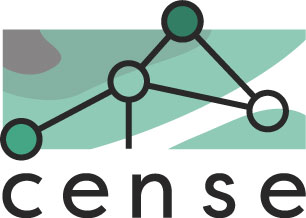The scientific closure of the project was achieved through the organization of a special session "Low-cost sensor networks for noise monitoring and advanced characterization of urban sound environments" at the international congress Euronoise 2021 from 25 to 27 October 2021. This session allowed to present a synthesis of the works of the different working groups (WP1 to WP5), which you can find the videos below. This session allowed to widen the scientific discussion thanks to the presentation of 7 other scientific contributions by the international community.
Scientific closing of the project
Project synthesis (WP1)
 Download the paper
765 Ko
Download the paper
765 Ko
Abstract- The CENSE project, funded by the French Research National Agency from 2017 to 2021, aimed at proposing a new methodology for the production of more realistic noise maps. CENSE stands for “Characterization of urban sound environments: Modelling, noise sensors network and open data”. The project relied on a dense network of low-cost sensors deployed in an experimental site in the city of Lorient (France), and data assimilation techniques between simulated and measured data. Beyond the production of physical indicators, the project was also positioned on the characterization of sound environments. The project, has produced advances on noise modelling, low-cost sensor network technologies, data assimilation techniques applied to sound levels prediction, urban sound recognition, and perception. This first presentation, of a series of five, corresponding of each project work package, will give a general overview of the project, and its operational outputs.
Abstract
The CENSE project, funded by the French Research National Agency from 2017 to 2021, aimed at proposing a new methodology for the production of more realistic noise maps. CENSE stands for “Characterization of urban sound environments: Modelling, noise sensors network and open data”. The project relied on a dense network of low-cost sensors deployed in an experimental site in the city of Lorient (France), and data assimilation techniques between simulated and measured data. Beyond the production of physical indicators, the project was also positioned on the characterization of sound environments. The project, has produced advances on noise modelling, low-cost sensor network technologies, data assimilation techniques applied to sound levels prediction, urban sound recognition, and perception. This first presentation, of a series of five, corresponding of each project work package, will give a general overview of the project, and its operational outputs.
Noise mapping (WP2)
 Download the paper
875 Ko
Download the paper
875 Ko
Abstract
The relevance of noise maps for large cities following the European Directive 2002/49/EC is questionable, because of poor quality or insufficient accessibility of input data and the large number of input parameters. In the framework of the CENSE project, a sensitivity analysis of noise mapping models to their inputs is proposed in two parts. On one hand, the integration of different sources of data, from academic or open access databases such as OpenStreetMap, was analyzed. On the other hand, a global sensitivity analysis with the Morris method was carried out on 15 of the input parameters of the CNOSSOS-EU models (Directive UE 2015/996). These two studies help to better label and qualify the input data by prioritizing some sources of information and parameters. All these developments were integrated into the open-source tool NoiseModelling ensuring the reproducibility of the results. Acoustic predictions were also compared with available online noise maps for a few French cities.
Low-cost sensors network (WP3)
 Download the paper
3.71 Mo
Download the paper
3.71 Mo
Abstract
The technological advent of low cost microphones and innovative airborne data transfer protocols allows the deployment of a new type of gathering of information from the acoustic urban environment. The CENSE network is a prototype network that is based on a hydrid data network with airborne transmission from autonomous sensor nodes to gateways that are connected to the processing and storage servers using powerline network technology. This network, deployed in the downtown area of the city of Lorient, is designed to provide information, with a high level of privacy, about the acoustic environment at a high spatial and temporal resolution. In this paper, we propose to describe the whole infrastructure, in particular, the design of the sensors, the signal processing applied to the measurements, the data collection and representation. The feedback from this project allows us to consider the evolution of the network for an operational use.
Metamodelling and data fusion (WP4)
 Download the paper
459 Ko
Download the paper
459 Ko
Abstract
Urban noise mapping can be sped up replacing the traditional noise mapping model with a meta-model. In the present study, in the framework of the CENSE project, a meta-model was obtained by training on 2000 simulations of NoiseModelling software, on part of Paris. It is based on dimension reduction of inputs and outputs of NoiseModelling. The reduced model is then approximated by a statistical emulator. The resulting meta-model can closely reproduce any NoiseModelling noise map for Paris under any typical traffic condition, but with a computational time about 10000 times lower. The meta-model is then employed to assimilate acoustic measurements from 16 locations. State estimation, inverse modeling and joint state-parameter estimation are compared and evaluated using cross validation. The most accurate noise map is obtained with joint state-parameter estimation, without a priori knowledge about traffic and weather.
Soundscape perception (WP5)
Abstract
The urban sound quality depends not only on the perceived loudness, but also on the perceived presence ratios of traffic sounds, human sounds and sounds of nature. In the framework of the CENSE project, these perceptual variables (presence ratios of traffic, voices and birds) have been estimated automatically, thanks to a deep learning process, from acoustic data collected on a network of sensors in the city of Lorient. The time evolutions of these sound presence ratios follow the day rhythm of the city (birds singing during the sunrise, regular pattern for the traffic, voices during weekends along the walking areas, etc.). In parallel a questionnaire sent to the population made it possible to propose a sound quality model adapted to the city of Lorient. The crossing of the measurements with the perceptual data is under process, as well as the development of a cartographic representation of the sound quality, with a focus on the presence of these sound sources.

